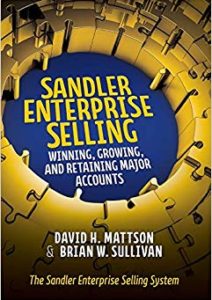Recently, I had a planning session with a CSO from an HR services firm that had just landed their first large client, a Fortune 500 pharmaceutical company. As you might guess, she was very excited about this significant achievement and its potential for game-changing new revenue and profit.
The journey from serving small and medium-sized accounts to winning business with major accounts can be a long one. And success in this endeavor quite often requires a little bit of luck and being in the right place at the right time, as was the case with this big pharma win. The key decision-maker in the new account was an ex-client that the CSO’s organization had effectively served for years, paving the way for the big win. You know what they say – the harder you work, the luckier you get!
While the pursuit had been long, challenging and costly, the payoff of winning can be huge. For major accounts are ecosystems of growth and with the business won, your ability to deliver with excellence sets the stage for long-term growth.
In my discussion with the CSO, we focused on just how to make that long-term growth happen by focusing on the teaming of sales and delivery. The dreaded hand-off is simply unworkable with enterprise accounts. Just as engaging delivery team members in pursuits increases the chances of winning, the continued involvement of sales with delivery drives growth. This continuous process of teaming seeds long-term relationships. That’s the major account world.
With delivery excellence in place, having a framework to follow is critical. I like to focus on five channels to account expansion – Organic Growth, Partnerships and Alliances, Family Tree, Alumni and Customer’s Customer. There are others, of course, but I see these as the most powerful.
Organic Growth, of course, is a strategy followed by most selling teams and often effectively. Not always, though, as organizations that divert the sales teams once the contract is signed struggle mightily with even this basic channel, which covers the extension or renewal of a current piece of business and its promising expansion into other departments. Also explored here is selling additional offerings from your portfolio to the many areas in the organization. In short, Organic Growth is going deep and wide in both the account and in your product/service portfolio.
The next channel is Partnerships and Alliances. In winning major account deals, you often partner with firms whose capabilities enhance your solution. Additionally, while delivering, you likely connect with other firms doing the same. Whether co-bidding or co-delivering, these alignments create fertile opportunities. But you must work proactively to grow these connections into mutual victories by actively planning for and with your partners.
The next focus area is the Family Tree channel, taking into account the vast array of opportunity in enterprise accounts’ broad networks. Parents, subsidiaries and sister companies are all potentially fruitful targets, with your successful service track record as the springboard to those entities. Think about it. If you’re serving Dairy Queen, the ice cream chain, why might you have potential opportunities with Benjamin Moore, the paint firm? Or Net Jets, the aviation leasing company or Geico, the insurer? Why? Because they’re all Berkshire-Hathaway companies – family members, if you will. Of course, there’s no guarantee that Dairy Queen would beg you to sell them your services simply because Geico is your client. Of course not. But the connection adds real warmth and credibility to the contact – a very promising start.
In enterprise accounts, decision-makers come and go, as our CSO’s pharmaceutical success story shows. The Alumni channel proposes tracking those who exit, potentially opening new doors where they land. And once you’ve proven your organization’s capabilities to the new client contacts who take their place, how about seeking their guidance and referrals into their ex-employers? Sure, it takes work. But again, adding a level of warmth to contacts is huge.
Last is Customer’s Customer. In serving major accounts, you often interact directly with their clients, the end customers directly benefiting from your services. What about potentially having these firms, already familiar with the quality of your work, as your clients as well? Of course, common sense must dictate your strategy and actions. You don’t randomly reach out to your client’s contacts without being respectful and communicative. But be smart and chances are your client will be supportive and often quite helpful.
In the end, in the enterprise world, you must truly believe that account growth is your obligation. Why? Because you owe it to yourself and your organization given the tangible benefits it delivers to you both. But most importantly, you owe it to your clients, who made decisions to invest in you as their partner. Neglecting to seek every possible way to deliver additional value would be doing them a great disservice. So, internalize that mindset, follow the framework and grow!












Comments